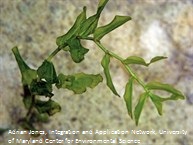
Ecological Importance
Clasping leaf pondweed produces a fruit which can be important for a variety of ducks and geese. Muskrat, deer, beaver and moose can be found grazing on this plant. The leaves and stems of Clasping Leaf pondweed are colonized by invertebrates and provide cover for fish.
Problems
Dense populations can reduce water temperature by over shading the water along with blocking sunlight to other submersed vegetation. Oxygen concentrations may rapidly decline as these plants die in late summer. Clasping Leaf Pondweed may form dense mats interfering with fishing, boating and swimming.
Plant Description
This pondweed gets its name from the leaves which partially surround its stems. Clasping-leaf pondweed can be easily identified by its thin, delicate, oval shaped leaves.
The leaves are wide with a broad base that 'clasps' the stem. Easily visible veins run the length of each leaf, 10 to 16 weaker veins, and usually wavy margins. The leave's edges are smooth and the tip comes to a point. The leaves are typically between 3 and 12 centimeters in length. Stipules are between 1 and 2 centimeters long and are found wrapped around the stems near the base.

Hints to Identify:
Clasping-leaf pondweed can sometimes be confused with curly-leaf pondweed. The easiest way to tell the two species apart is to look at the tips of the leaves. Clasping-leaf tips will come to a point while curly-leaf tips will be blunt and rounded.
Common Application Questions
Q. How much should I treat?
A. Spot treat as needed to maintain navigation channels and swimming areas. Remember this plant is very beneficial and should not be treated where it is not a nuisance.
Q. When is the best time to treat?
A. Once water temperatures are around sixty degrees or warmer however this plant responds equally well to herbicide treatment when mature.
Q. How often do I need to treat Clasping Leaf Pondweed?
A. One treatment per season is usually enough.
Q. How long before I see results?
A. Generally within two to three weeks things will be cleared up.
| Homeowner Treatment Options |
| Aquathol K |
| Aquathol Super K |
| Hydrothol® Granular |
| Sonar AS |
| Sonar RTU |
| *Aquatic Biologists recommends implementing preventative management techniques and physical removal prior to, or in conjunction with treatment. |
